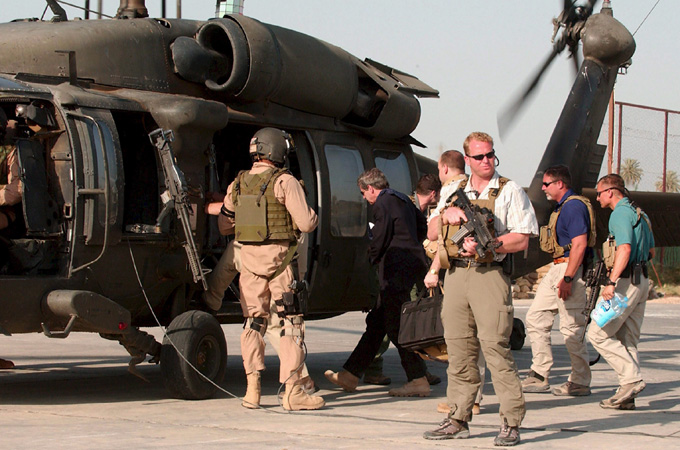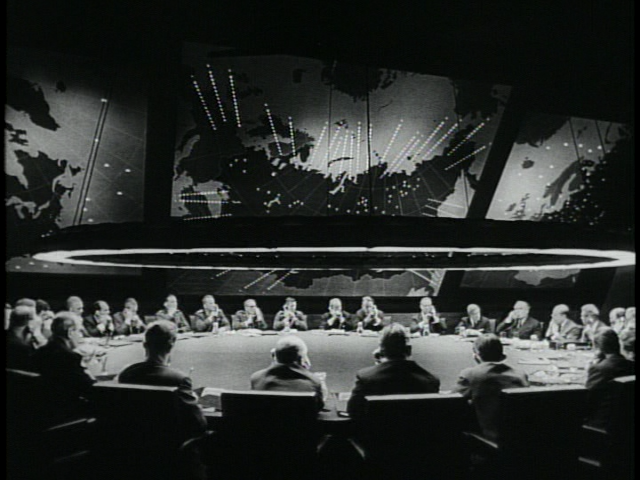“Until the latest of our world conflicts, the United States had no armaments industry. American makers of ploughshares could, with time and as required, make swords as well. But we can no longer risk emergency improvisation of national defense; we have been compelled to create a permanent armaments industry of vast proportions.”
In 1961, during his farewell speech from the White House, President Dwight D. Eisenhower presented his nation with a warning about the power of the relationship between the growing arms industry, its advocates and the country’s political representatives, and those of the elite military command. These were remarkable words coming from a five-star general who helped lead the Allies on D-Day, introducing to the world a term that has lived for some in infamy: the “military-industrial complex”. This foresight is deserving of reflection and consideration, and makes up the focus of this two-part series of articles.
[captionpix align=”left” theme=”elegant” width=”300″ imgsrc=”http://natoassociation.ca/wp-content/uploads/2014/04/hal_mhc_am_arsenal_web_174329_7.jpg”]
I want to avoid the much discussed, or often heavily intoned, normative question of whether or not we ought to have the military-industrial complex. This is not because I don’t think it is an important question – it is, but because I want to point out that this phenomenon exists because of a confluence of contingent structural factors. Eisenhower’s foresight lay in identifying and making explicit a portion of the modern industrialized nation-state that he believed should be checked by a knowledgeable and concerned electorate. He recognized that the military-industrial complex is not merely a matter of choice or policy, and that until these structural forces that give rise to it change, the best course of action in controlling the political power of the world’s destructive forces was awareness and public debate. This series will attempt to briefly discuss these structural factors that give rise to the military-industrial complex. Part one will cover a short historical overview. Part two will address what it means today, as well as where we may be going.
The military-industrial complex refers directly to the “locked-in” nature of the procurement relationship between the arms industry and government, as well as the associated vested financial interests in conflict-preparedness. Eisenhower’s speech presents something of an anachronism in implying that the military-industrial complex was a then-recent phenomenon. Most accounts link its inception to developments occurring at the end of the 19th century, including the rapid pace of industrialization sweeping much of the globe. One important change involved the steady shift in military production away from publicly-owned enterprises, a change largely attributable to the rising complexity of the private sector and the associated innovations that flowed from it.
An oft-cited example of such innovation is the Whitehead Torpedo. Invented in 1866 by a British engineer named Robert Whitehead, the torpedo was a technological wonder for its day, and one that was almost single-handedly changing the way naval warfare was conducted. Under intellectual property protection, Whitehead sold the technology to governments around the world. Eventually, the US firm E. W. Bliss Co. began producing this torpedo for the US Navy. It became apparent that as the market became increasingly saturated, the competitive advantage endowed by this new technology began to disappear. Endeavouring to procure more advanced torpedoes, the US government turned to the only place that had the technical capacity and expertise to design and produce new torpedoes. Eventually, this relationship was locked-in through unprecedented legislation. Selling the new design abroad became prohibited by the government lest it level the playing field once again. Under the National Defense Secrets Act of 1911 (today the Espionage Act in the US and the Defence Production Act in Canada), intellectual property could be converted into national security information. This bound the firm to the market created by the state, and bound the state to the holders of intellectual property sought after for its security needs.
[captionpix align=”left” theme=”elegant” width=”300″ imgsrc=”http://natoassociation.ca/wp-content/uploads/2014/04/lockheed-martin-f-22-raptor-production.jpg”]
This example is roughly representative of the evolution of the relationship between government and the private sector. Crucially, the market created by the state was at this point in time expanding, drawing many private firms into industrial competition for a partnership with the state. The Concert of Europe, an international balance of power order lasting from the early 19th century to World War I, engendered the swift modernization of military practices and the introduction of advanced military sciences. When this order broke down in 1914, new military industrial technologies saw their fullest and most devastating expression on the battlefield yet. It was clear that maintaining a competitive technological edge meant the difference between winning and losing a war.
Of course, the same rush of production and military spending occurred during the Second World War, but a key difference was observable in what followed. Western countries, particularly the United States, maintained large standing armies into what was ostensibly peace-time. The persistent threat of the security dilemma posed by the Cold War and a reliance on the cutting edge of technological innovation meant that the market was more stable and amenable to new players. As noted in an article by the US’ National Public Radio, whereas Ford would build everything from jeeps to bombers and then return to building cars after wartime, new firms who specialized in defence technology emerged en-force to supply the military with a constant supply of new defence technology for its increasingly vast security needs.
Two interrelated structural themes are identifiable in this historical sketch that are prevalent today, playing a crucial role in upholding the current military-industrial-political order: the collision of economics and geopolitics in the context of the modernizing nation-state.
Please join me next in exploring how this plays out in contemporary practice, and to discuss how this could change in the future.




